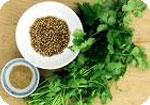| Tuesday, 13 May 2025 Home • About Us • Contact Us |
|
|
|
You are here:
The scholar Ibn al-Qayyim in his Prophetic Medicine mentions coriander and the benefits of eating coriander with certain meat to rectify its negative effects on the body.
Coriander (Coriandrum sativum), or cilantro as it is also known as, is used as both a herb (the leaves) and a spice (the seeds). Fresh coriander leaves resemble its close family member, flat-leaf parsley. Coriander seeds are dried when used as a spice, and have a similar flavor to citrus peel and sage, they are available in whole or ground forms. The oil found in coriander is rich in a variety of phytonutrients including carvone, geraniol, limonene, borneol, camphor, elemol and linalool. Coriander also contains flavonoids and active phenolic acid compounds, including caffeic and chlorogenic acid, which have been found helpful in fighting cancer, diabetes and heart disease. Coriander is a source of magnesium and manganese. Health Benefits When coriander was added to the diet of diabetic mice, it helped stimulate their secretion of insulin and lowered their blood sugar. Coriander was given to rats that had been fed a high-fat and high-cholesterol diet. The spice lowered total cholesterol and triglycerides significantly. Antibacterial Benefits Researchers isolated a compound in coriander called dodecenal, which in laboratory tests was twice as effective as the commonly used antibiotic drug gentamicin at killing salmonella. Digestive health Researchers examined the effect of coriander combined with other spices on digestion and found the spice mix enhanced the activities of pancreatic enzymes and also stimulated bile flow and secretion. Tips on Using Coriander
References
Link to this article: Show: HTML Link • Full Link • Short Link
Related Articles:
You must be registered and logged in to comment. |
|
 |
 | |
|
|








